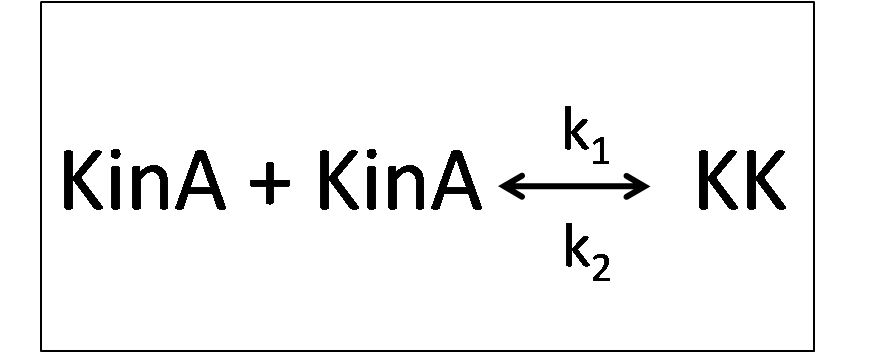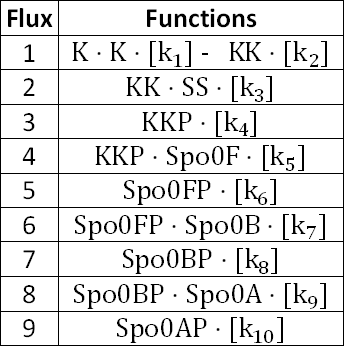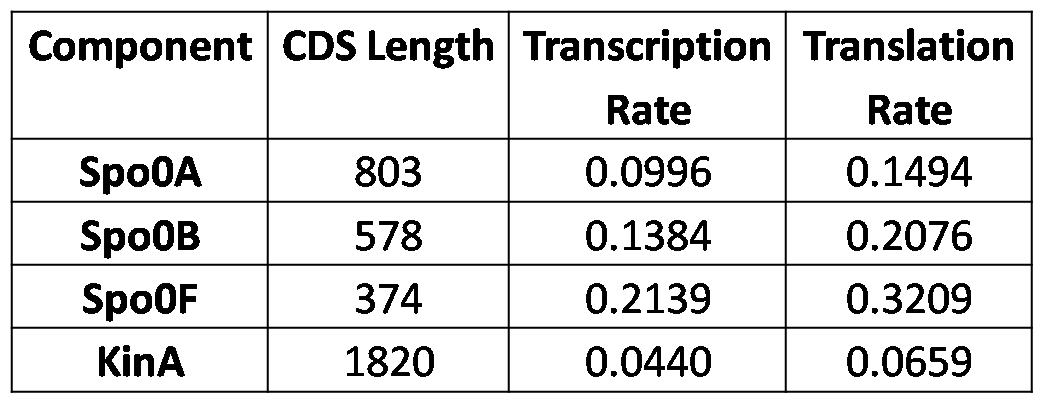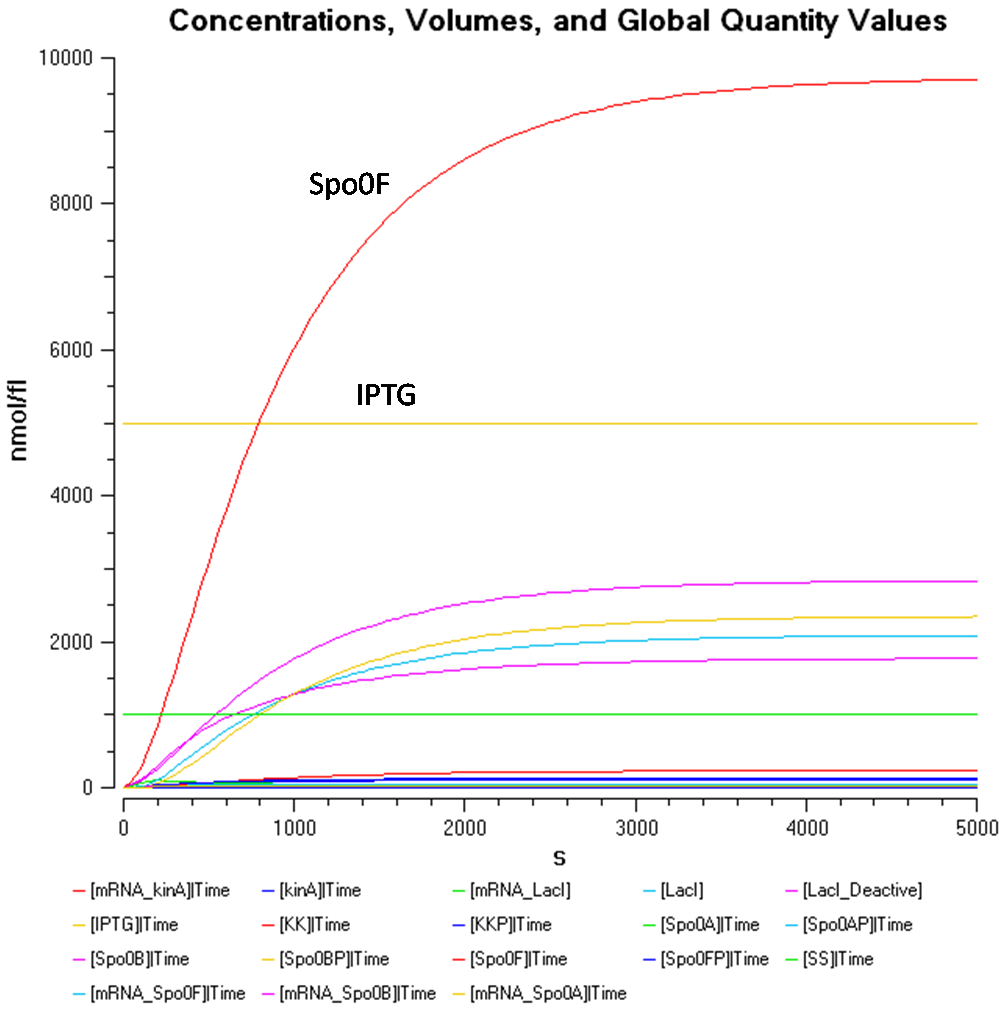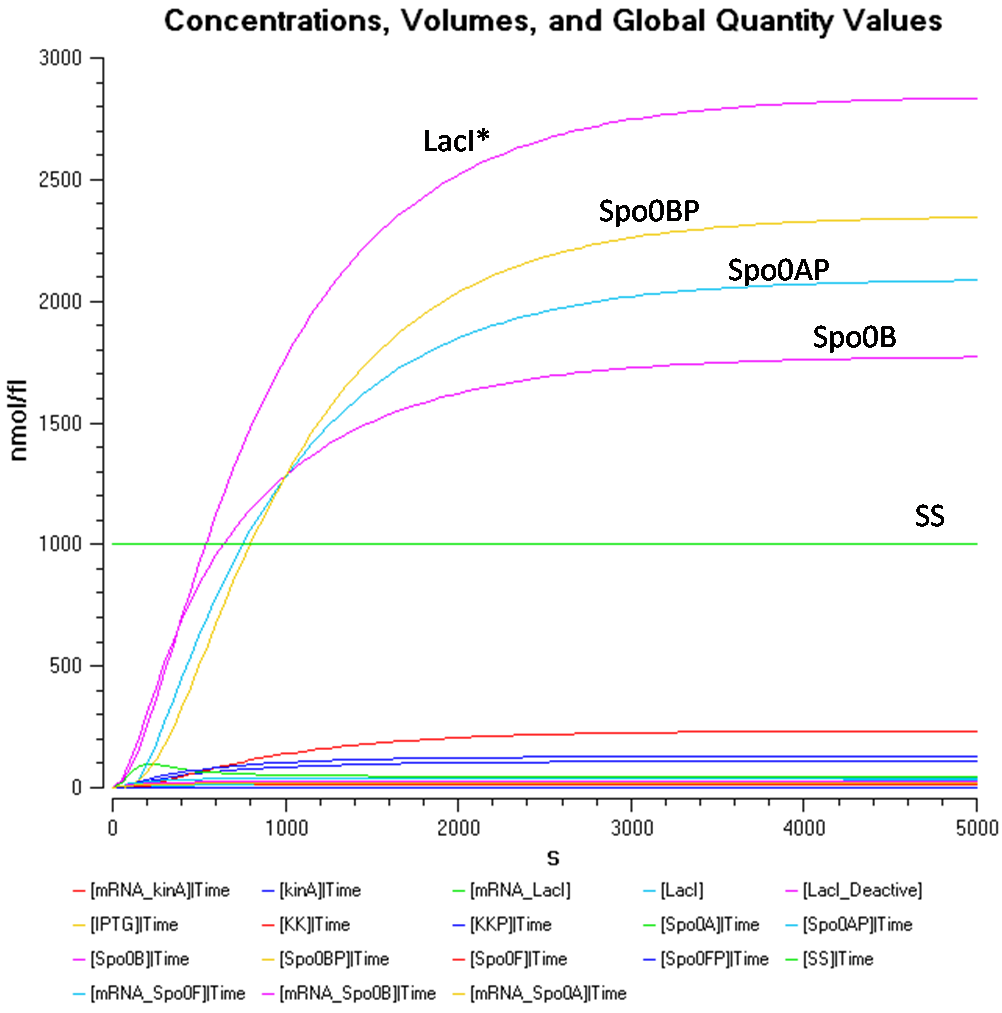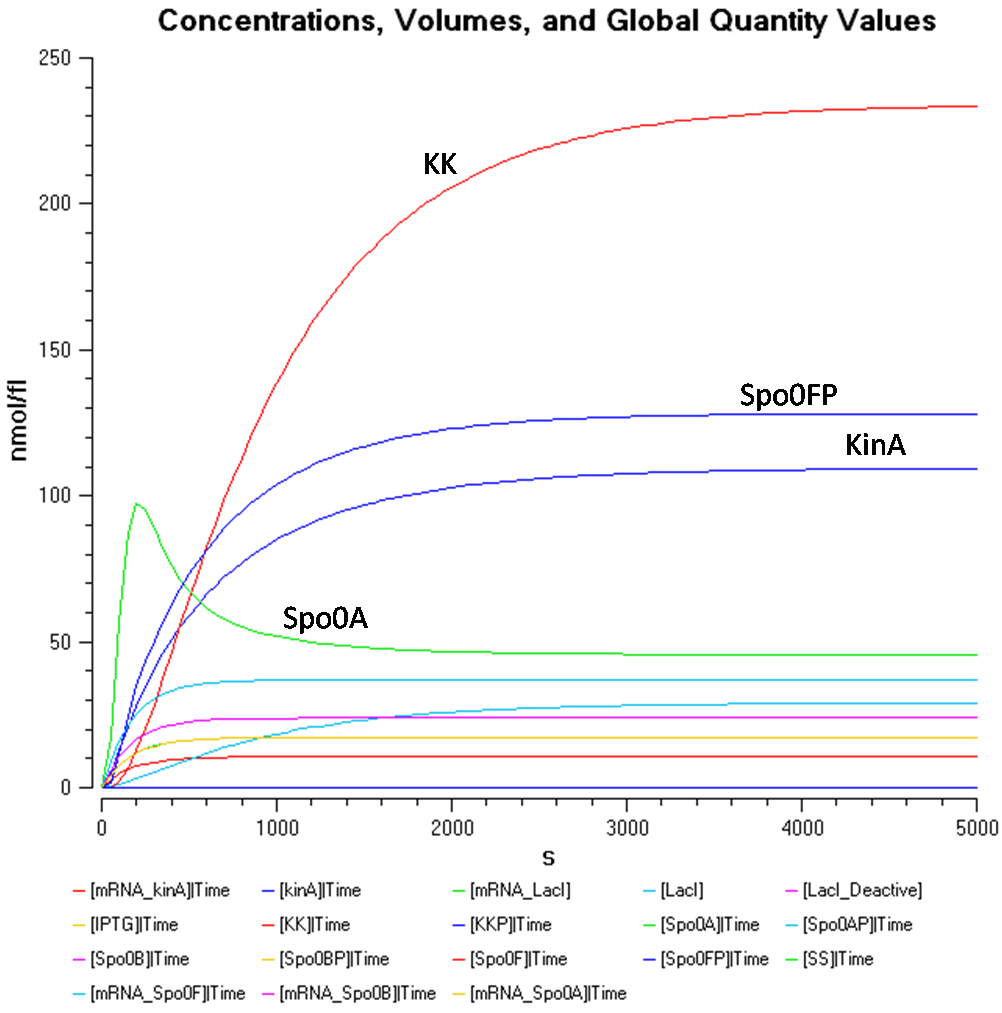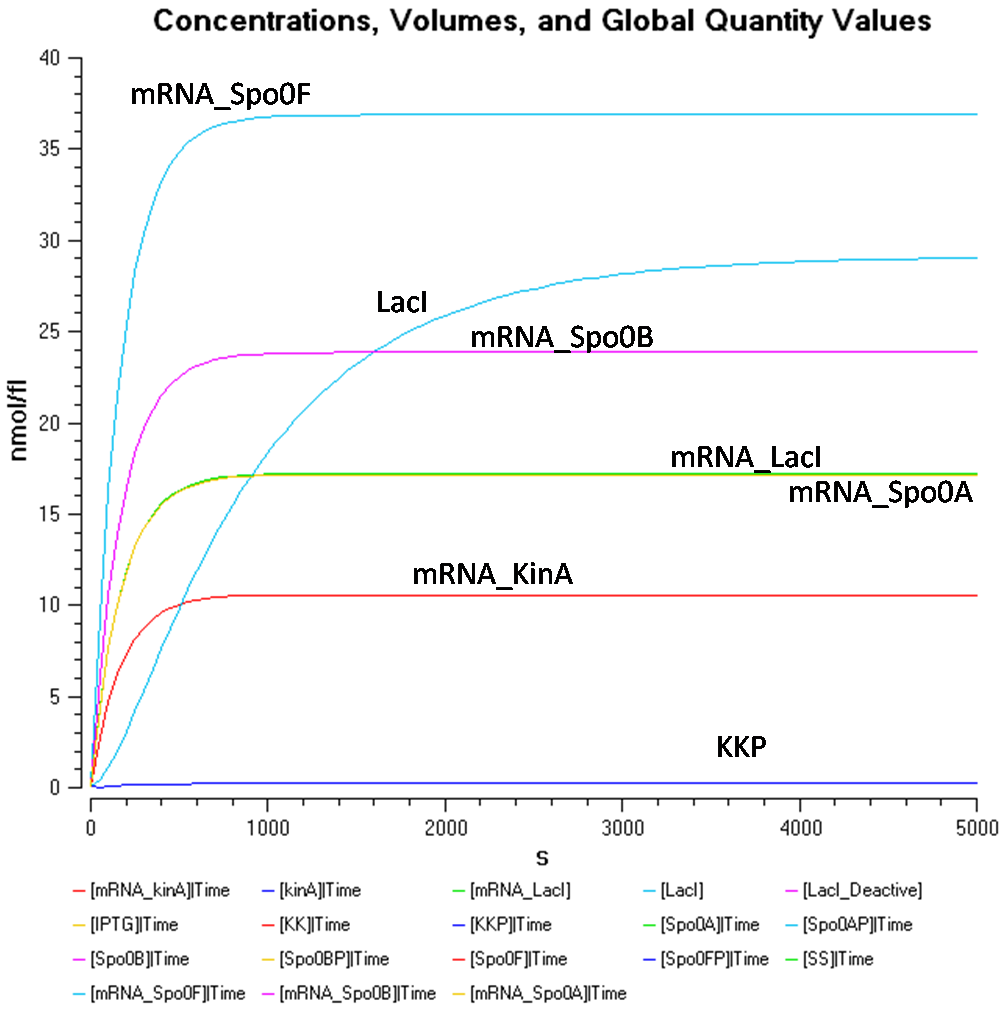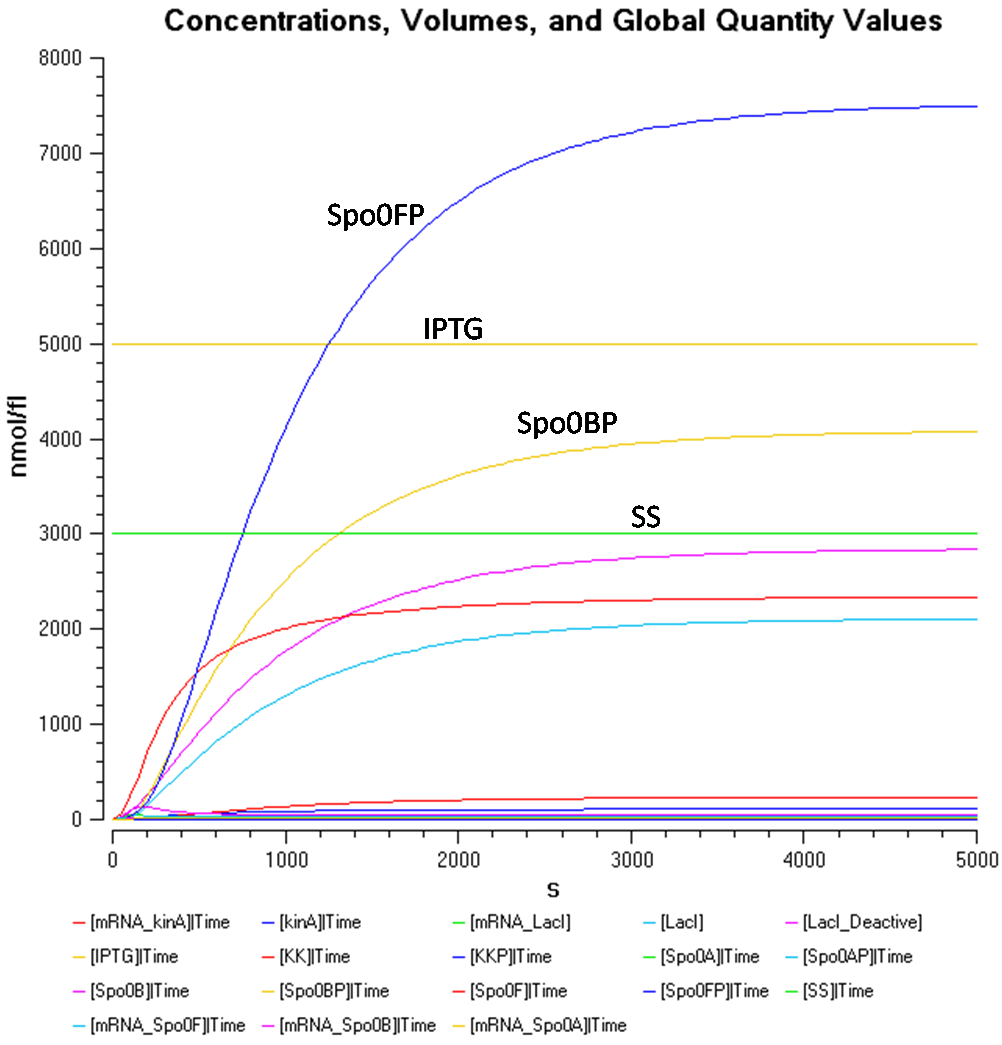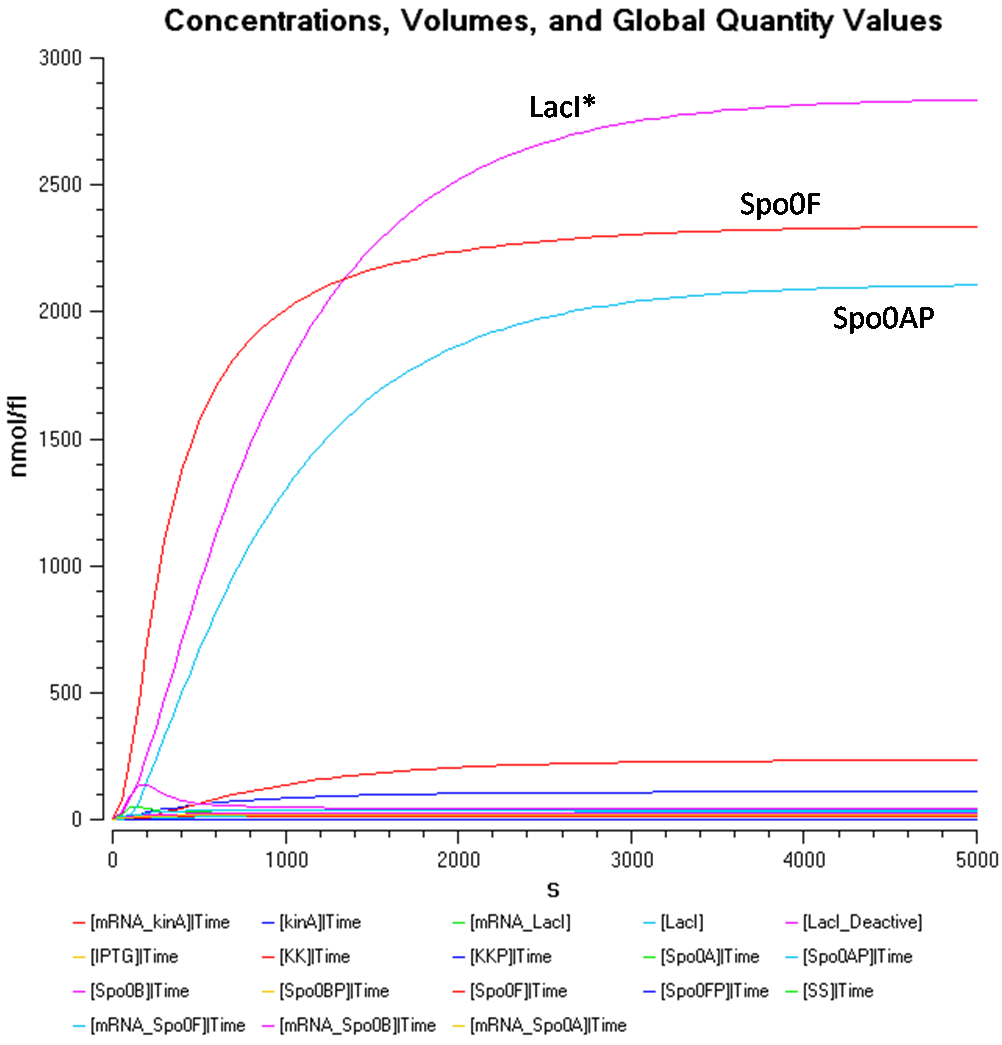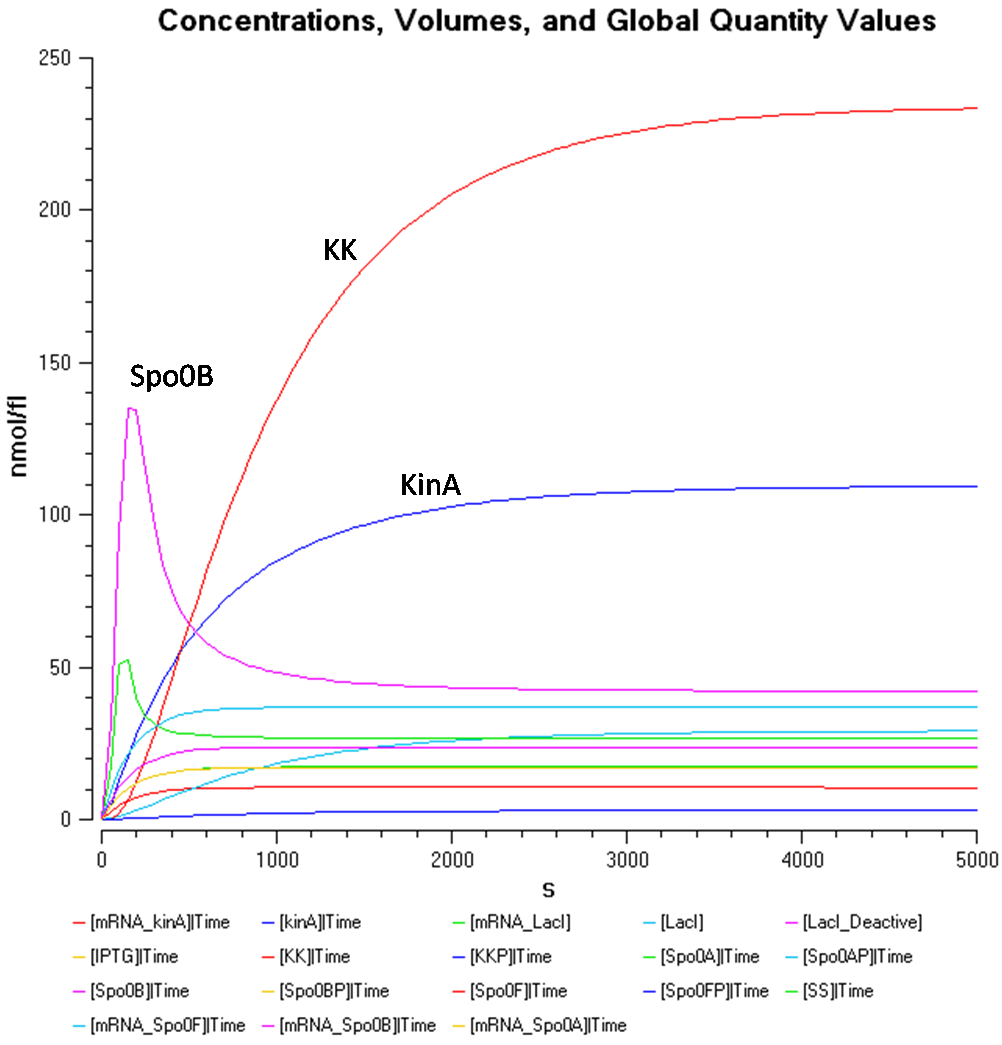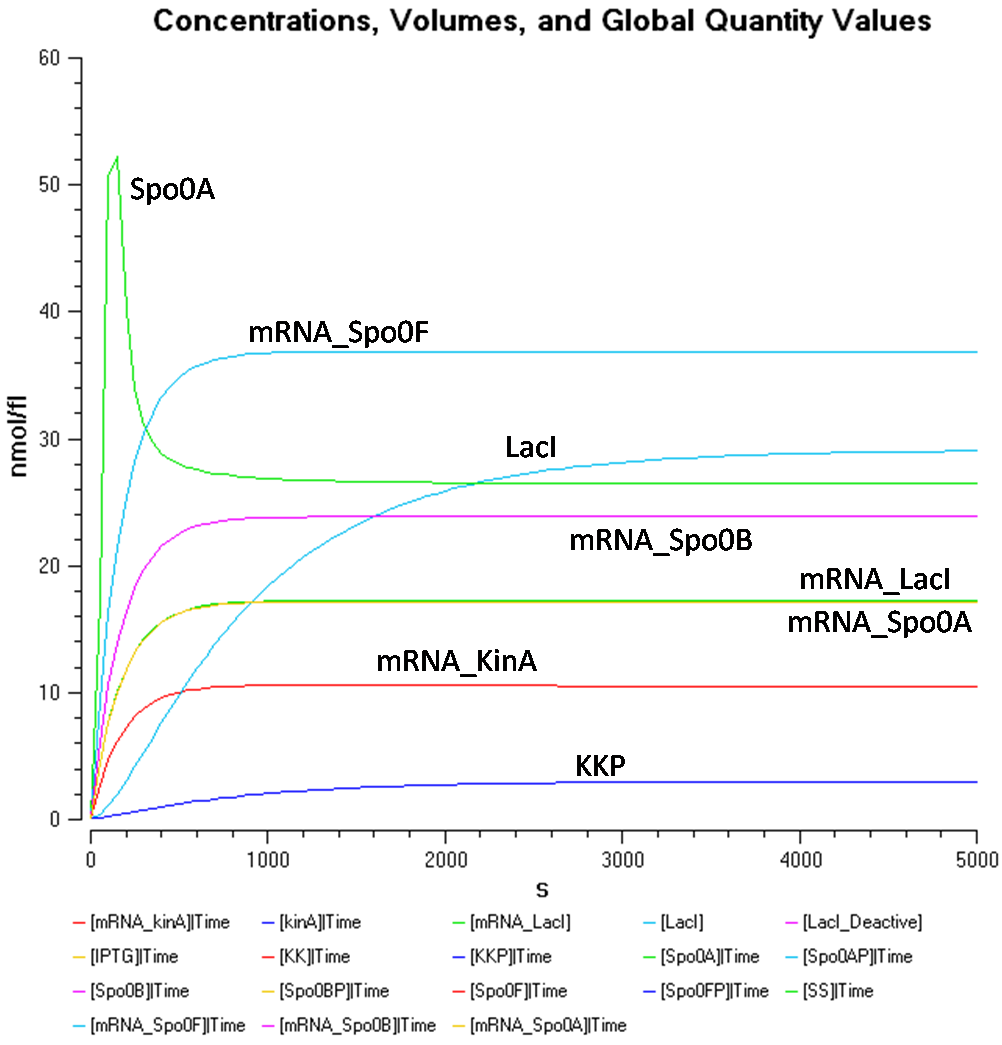Team:Newcastle/Modelling/SporulationTuning
From 2009.igem.org
(→KinA Expression Model) |
(→Sporulation Tuning Model) |
||
| (13 intermediate revisions not shown) | |||
| Line 2: | Line 2: | ||
{{:Team:Newcastle/Header}} | {{:Team:Newcastle/Header}} | ||
{{:Team:Newcastle/Left}} | {{:Team:Newcastle/Left}} | ||
| - | ==Sporulation Tuning== | + | ==Sporulation Tuning Model== |
| + | The expression of KinA has been modelled as seen above, therefore we can now proceed further into the Sporulation Tuning Model, which is built from the KinA Expression Model with COPASI. | ||
| - | + | To proceed with the modelling of our Sporulation Tuning Model, we have decided that in response to an unidentified stimuli, where KinA autophosphorylates and then donates its phosphate groups to the response regulator Spo0F, the unidentified stimuli will be termed as 'sporulation signal'.<sup>[5]</sup> | |
| - | + | Also, to simplify the modelling, the phosphatases that provide access for negative signals to influence the cell’s decision whether to sporulate or to continue vegetative growth,<sup>[4]</sup> such as Spo0E<sup>[1]</sup>, YisI, and YnzD,<sup>[5]</sup> are not taken into consideration while building this model. | |
| - | + | The following equations describe the model: | |
| + | [[Image:TeamNewcastleSporeTuneEqn1.png|170px|center]] | ||
| + | <center>''Equation 1''</center> | ||
| - | + | [[Image:TeamNewcastleSporeTuneEqn2.png|130px|center]] | |
| - | [[Image: | + | <center>''Equation 2''</center> |
| + | [[Image:TeamNewcastleSporeTuneEqn3.png|100px|center]] | ||
| + | <center>''Equation 3''</center> | ||
| - | |||
| - | |||
| + | As Spo0F lacks an output domain and is incapable of activating transcription; it serves only as an intermediary in the phosphorelay. The phosphotransferase Spo0B transfers the phosphate from Spo0F~P to Spo0A.<sup>[4]</sup> | ||
| + | [[Image:TeamNewcastleSporeTuneEqn4.png|230px|center]] | ||
| + | <center>''Equation 4''</center> | ||
| - | |||
| - | [[Image: | + | [[Image:TeamNewcastleSporeTuneEqn5.png|160px|center]] |
| - | <center>'' | + | <center>''Equation 5''</center> |
| + | [[Image:TeamNewcastleSporeTuneEqn6.png|280px|center]] | ||
| + | <center>''Equation 6''</center> | ||
| - | |||
| - | + | [[Image:TeamNewcastleSporeTuneEqn7.png|160px|center]] | |
| - | [[Image: | + | <center>''Equation 7''</center> |
| + | [[Image:TeamNewcastleSporeTuneEqn8.png|280px|center]] | ||
| + | <center>''Equation 8''</center> | ||
| - | |||
| - | |||
| + | [[Image:TeamNewcastleSporeTuneEqn9.png|160px|center]] | ||
| + | <center>''Equation 9''</center> | ||
| - | |||
| + | With respect to Equations 1 to 9, as seen above, the corresponding fluxes are as follows: | ||
| + | [[Image:TeamNewcastleSporeTuneFluxes2.png|200px|center]] | ||
| + | <center>''Fluxes''</center> | ||
| - | + | The phophorylated proteins Spo0FP, Spo0BP and Spo0AP will go through degradation, and the following equations, Equation 10, 11 and 12 describes degradation. | |
| - | + | ||
| + | [[Image:TeamNewcastleSporeTuneEqn10.png|80px|center]] | ||
| + | <center>''Equation 10''</center> | ||
| - | |||
| + | [[Image:TeamNewcastleSporeTuneEqn11.png|80px|center]] | ||
| + | <center>''Equation 11''</center> | ||
| - | + | [[Image:TeamNewcastleSporeTuneEqn12.png|80px|center]] | |
| - | [[Image: | + | <center>''Equation 12''</center> |
| - | + | As parameters such as transcription and translation rates could not be found in literature, the following equations were used to calculate the transcription and translation rates whenever possible. | |
| - | + | [[Image:TeamNewcastleSporeTuneTranscriptionRate.png|270px|center]] | |
| - | |||
| + | [[Image:TeamNewcastleSporeTuneTranslationRate.png|220px|center]] | ||
| - | |||
| - | [[Image: | + | Using the transcription and translation rate equations as seen above, the rates were calculated for the components Spo0A, Spo0B, Spo0F and KinA, and the results are reported in the table below. |
| + | |||
| + | [[Image:TeamNewcastleSporeTuneTranscriptionTranslateRate.png|330px|center]] | ||
| + | <center>''Table 1: Transcription and Translation Rates''</center> | ||
| + | |||
| + | |||
| + | For components where information on the CDS length could not be found, we used the value 0.1 for both the translation and transcription rate. | ||
| + | |||
| + | Also, the values for the various rate constants could not be found in literature either. Therefore, the following values were used: | ||
| + | |||
| + | k<sub>forward</sub> = 0.001 | ||
| + | |||
| + | k<sub>reverse</sub> = 0.05 | ||
| + | |||
| + | Other parameters and formulas which were used in this model are as follows: | ||
| + | |||
| + | Protein Degradation Rate = 0.0012 | ||
| + | |||
| + | mRNA Degradation Rate = 0.0058 | ||
| + | |||
| + | |||
| + | [[Image:TeamNewcastleSporeTuneFunctions.png|600px|center]] | ||
| + | <center>''Table 2: Functions used in the KinA Expression and Sporulation Tuning Models''</center> | ||
| + | |||
| + | |||
| + | The CDS lengths was found on the [http://www.ncbi.nlm.nih.gov/Genbank/ GenBank] using the accession number, AL009126. | ||
| + | |||
| + | These parameters and functions were also used in the KinA Expression Model. | ||
| + | |||
| + | The Sporulation Tuning Model is available for download as follows: | ||
| + | * [[:Image:SporeTuneModel (SBML and Copasi).zip|Sporulation Tuning Model (SBML and COPASI)]] | ||
| + | |||
| + | ===Results=== | ||
| + | |||
| + | At a constant IPTG concentration of 5000nmol/fl, we vary the concentration of the sporulation signal, [SS] and the following graphs show the results. | ||
| + | |||
| + | <u>'''At [SS] = 1000nmol/fl'''</u> | ||
| + | |||
| + | [[Image:TeamNewcastleSporeTunePic1.png|500px|center]] | ||
<center>''Figure 1.1''</center> | <center>''Figure 1.1''</center> | ||
| - | + | Figure 1.1 shows that at an IPTG concentration of 5000nmol/fl and sporulation signal concentration of 1000nmol/fl, the Spo0F concentration gets significantly higher than the other components. | |
| + | In order to take a better look at the behaviour of the rest of the components, the following graphs were produced. | ||
| - | [[Image: | + | |
| + | [[Image:TeamNewcastleSporeTunePic2.png|500px|center]] | ||
<center>''Figure 1.2''</center> | <center>''Figure 1.2''</center> | ||
| - | Figure 1.2 | + | From Figure 1.2, the concentration of Spo0AP seems to be at a healthy concentration. |
| - | |||
| + | [[Image:TeamNewcastleSporeTunePic3.png|500px|center]] | ||
| + | <center>''Figure 1.3''</center> | ||
| - | |||
| - | [[Image: | + | [[Image:TeamNewcastleSporeTunePic4.png|500px|center]] |
| + | <center>''Figure 1.4''</center> | ||
| + | |||
| + | |||
| + | <u>'''At [SS] = 3000nmol/fl'''</u> | ||
| + | |||
| + | The concentration of the sporulation signal, [SS] is increased to 3000nmol/fl in the following graphs, and the results were investigated. | ||
| + | |||
| + | [[Image:TeamNewcastleSporeTunePic5.png|center|500px]] | ||
<center>''Figure 2.1''</center> | <center>''Figure 2.1''</center> | ||
| - | + | With a stronger sporulation signal, the concentration of Spo0FP and Spo0BP increased significantly, while the concentration of Spo0F dropped significantly from approximately 9000nmol/fl to 2300nmol/fl, comparing Figure 1.1 to 2.1. | |
| - | [[Image: | + | [[Image:TeamNewcastleSporeTunePic6.png|500px|center]] |
<center>''Figure 2.2''</center> | <center>''Figure 2.2''</center> | ||
| - | + | The concentration of LacI* remained approximately the same, so as Spo0AP. | |
| + | |||
| + | |||
| + | [[Image:TeamNewcastleSporeTunePic7.png|center|500px]] | ||
| + | |||
| + | |||
| + | <center>''Figure 2.3''</center> | ||
| + | |||
| + | |||
| + | [[Image:TeamNewcastleSporeTunePic8.png|center|500px]] | ||
| + | <center>''Figure 2.4''</center> | ||
| + | |||
| - | + | Comparing Figure 1.3 and 2.4, the concentration of Spo0A falls from approximately 100nmol/fl to 50nmol/fl when [SS] is increased. | |
| - | |||
| - | |||
| + | Referring to the graphs obtained from the model, it seems like increasing the sporulation signal concentration, does not increase the Spo0AP concentration. However, the concentrations of Spo0BP and SpoFP did increase as the sporulation signal concentration increased. | ||
| - | |||
| + | ===Other Models=== | ||
| - | [[ | + | : '' See [[Team:Newcastle/Modelling/KinAExpression|KinA Expression Model]]'' |
| - | + | ||
| + | : '' See [[Team:Newcastle/Modelling/SinOperon|Sin Operon Model]]'' | ||
| - | |||
{{:Team:Newcastle/Footer}} | {{:Team:Newcastle/Footer}} | ||
{{:Team:Newcastle/Right}} | {{:Team:Newcastle/Right}} | ||
Latest revision as of 22:07, 21 October 2009
Sporulation Tuning Model
The expression of KinA has been modelled as seen above, therefore we can now proceed further into the Sporulation Tuning Model, which is built from the KinA Expression Model with COPASI.
To proceed with the modelling of our Sporulation Tuning Model, we have decided that in response to an unidentified stimuli, where KinA autophosphorylates and then donates its phosphate groups to the response regulator Spo0F, the unidentified stimuli will be termed as 'sporulation signal'.[5]
Also, to simplify the modelling, the phosphatases that provide access for negative signals to influence the cell’s decision whether to sporulate or to continue vegetative growth,[4] such as Spo0E[1], YisI, and YnzD,[5] are not taken into consideration while building this model.
The following equations describe the model:
As Spo0F lacks an output domain and is incapable of activating transcription; it serves only as an intermediary in the phosphorelay. The phosphotransferase Spo0B transfers the phosphate from Spo0F~P to Spo0A.[4]
With respect to Equations 1 to 9, as seen above, the corresponding fluxes are as follows:
The phophorylated proteins Spo0FP, Spo0BP and Spo0AP will go through degradation, and the following equations, Equation 10, 11 and 12 describes degradation.
As parameters such as transcription and translation rates could not be found in literature, the following equations were used to calculate the transcription and translation rates whenever possible.
Using the transcription and translation rate equations as seen above, the rates were calculated for the components Spo0A, Spo0B, Spo0F and KinA, and the results are reported in the table below.
For components where information on the CDS length could not be found, we used the value 0.1 for both the translation and transcription rate.
Also, the values for the various rate constants could not be found in literature either. Therefore, the following values were used:
kforward = 0.001
kreverse = 0.05
Other parameters and formulas which were used in this model are as follows:
Protein Degradation Rate = 0.0012
mRNA Degradation Rate = 0.0058
The CDS lengths was found on the [http://www.ncbi.nlm.nih.gov/Genbank/ GenBank] using the accession number, AL009126.
These parameters and functions were also used in the KinA Expression Model.
The Sporulation Tuning Model is available for download as follows:
Results
At a constant IPTG concentration of 5000nmol/fl, we vary the concentration of the sporulation signal, [SS] and the following graphs show the results.
At [SS] = 1000nmol/fl
Figure 1.1 shows that at an IPTG concentration of 5000nmol/fl and sporulation signal concentration of 1000nmol/fl, the Spo0F concentration gets significantly higher than the other components.
In order to take a better look at the behaviour of the rest of the components, the following graphs were produced.
From Figure 1.2, the concentration of Spo0AP seems to be at a healthy concentration.
At [SS] = 3000nmol/fl
The concentration of the sporulation signal, [SS] is increased to 3000nmol/fl in the following graphs, and the results were investigated.
With a stronger sporulation signal, the concentration of Spo0FP and Spo0BP increased significantly, while the concentration of Spo0F dropped significantly from approximately 9000nmol/fl to 2300nmol/fl, comparing Figure 1.1 to 2.1.
The concentration of LacI* remained approximately the same, so as Spo0AP.
Comparing Figure 1.3 and 2.4, the concentration of Spo0A falls from approximately 100nmol/fl to 50nmol/fl when [SS] is increased.
Referring to the graphs obtained from the model, it seems like increasing the sporulation signal concentration, does not increase the Spo0AP concentration. However, the concentrations of Spo0BP and SpoFP did increase as the sporulation signal concentration increased.
Other Models
- See Sin Operon Model
News
Events
- 20 – 21 June 2009 - Europe workshop (London)
- 23 – 24 June 2009 - UK iGEM meetup (Edinburgh)
- 23 October Practice Presentation (Newcastle)
- 23 October T-shirts are ready
- 27 October Practice Presentation (Sunderland)
- 27 October Poster is ready
- 30 October – 2 November 2009 - Jamboree (Boston)
Social Net
- Newcastle iGEM Twitter
- [http://www.facebook.com/home.php#/group.php?gid=131709337641 Newcastle on Facebook]
- [http://www.youtube.com/user/newcastle2009igem Newcastle Youtube Channel]
 "
"

